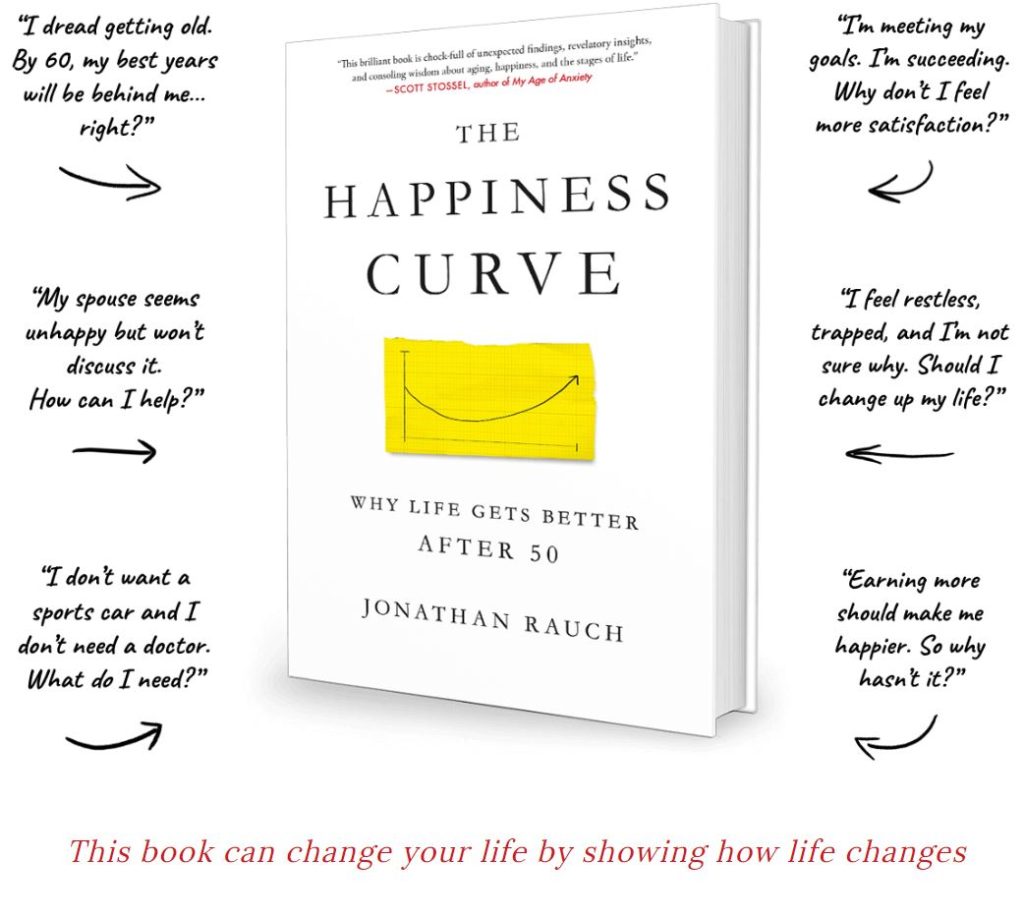The Happiness Curve Wrap Up
 What’s it mean?
What’s it mean?
So you remember the last couple shows I’ve been talking about age and happiness. You might remember it as “blah, blah, blah old, blah, blah, blah happy…”
No Seriously. I finished reading “The Happiness Curve, why life gets better after 50” by Jonathan Rauch. I quite enjoyed it and I think you would too.
The premise of the book is that researchers and psychologists have been able to show that there is a U-shaped curve throughout life. If you plot perceived happiness on the Y axis and age on the X axis you will see the pattern.
When people are young, they are happy. As they move towards middle age they become increasingly less happy. But there’s an inflection point in the late forties, early fifties where the perceived happiness starts to trend up again.
This u-shaped curve, the shape of it, is the same across cultures, countries, time and demographics. It’s a big data thing. It doesn’t mean you will be happier suddenly when you turn 50. It means this curve is the observable, measurable trend across the population.
How do they get this data? They ask a simple question. “On a scale of 1 – 10 what is your level of satisfaction with your life today?”
And that produces this curve.
Another question they ask is “How do you expect it to be in 5 years?” The answers to this gives part of the explanations for the happiness curve.
When people are younger, they are overly optimistic about their future selves’ happiness. There is a positive bias to how happy they think they are going to be. Because of this when they get there and realize their forecast was off, it makes them less happy.
On the other hand, if you ask an older person how happy they are going to be in the future they have a different bias. They no longer over-bias to the positive side. Older people have lower expectations and a sort of don’t give a____ attitude so they are happier.
There are a couple of good ways to make yourself more miserable. One is to compare yourself to other people in your cohort who appear to be doing better than you. The other is to live in the past or the future, which we have talked about a lot recently so I’ll spare you the ‘live in the now’ speech.
There are ways to mitigate the curve as well. All those things that you hear in the pop-psychology topics work to some extent. Different things work more for some than others.
Positive reinforcement, meditation, good habits, thankfulness… all that stuff helps. Being happy with what you have and thankful for it makes you happier. Enjoying the season of life you’re in helps as well. Of course, exercise helps.
For most of us it’s not really a full-blown depression that comes on in middle age. It’s not even really unhappiness. It’s just a general malaise. A feeling of something is missing. A question of “Really? Is this all there is?”
When we hit that inflection point we come to grips with it and in a sense settle with it.
This plotting of the actual happiness curve flies in the face of some common assumptions and stereotypes of age. The culture just assumes that old people are miserable and lonely because they are old. How could you be happy when your body and mind are failing you?
It turns out that an aging body and mind are a challenge, but these challenges are outweighed by a satisfaction in living, in life. I find that quite refreshing.
Part of these cultural biases are because, until fairly recently, people didn’t live much past 60. If you did you were seen as waiting to die. In our modern world you have an additional life season. From the time you reach retirement age you typically have another 20 years to go!
There is some diminishing of abilities. Your mind and your body start to slow down. For this season of your life you want to move from doing to teaching. AS we discussed last time. Move towards using your vast store of experiences to help others. You have wisdom. Use that wisdom.
Part of the happiness curve may even be biological. If we think about evolutionary necessity, what use are old people? This is what the researchers call “the grandmother paradox”. What use are grandmothers to the future of the gene pool? It turns out they perform a protective function for the younger offspring that helps guarantee their DNA makes it through to the next generation.
That’s the happiness curve. Interesting. Well written. A solid book. A good story.
Go ahead and read it yourself.
